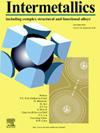Dependence of structure and property modification on individual doping between Cu and Ti in FeCrV multi-component alloys
IF 4.3
2区 材料科学
Q2 CHEMISTRY, PHYSICAL
引用次数: 0
Abstract
FeCrV multi-component alloys (MCAs) with trace amounts of Cu or Ti, synthetized via mechanical alloying and spark plasma sintering, have the characteristics of nanocrystalline and nano-precipitates, which contribute to their excellent mechanical properties at room temperature. The high thermal stability of nanostructure and exceptional irradiation resistance are of great significance for evaluating their potential advantages as advanced nuclear energy materials. In the present study, the response of structural stability and mechanical properties to the doping of Cu0.05 and Ti0.2 (at%) in FeCrV under series of annealing temperatures and durations was investigated systematically. FeCrVCu0.05 shows the satisfactory structure and performance stability until 600 °C for 30 h mainly due to the good thermal stability of Cu nano-precipitates (∼13 nm) and nanocrystalline (∼367 nm). In contrast, the excessive Laves phase of Fe2Ti appeared in FeCrVTi0.2 under the same annealing condition, exerting a detrimental impact on its high-temperature performance. Brittle FeV intermetallic compounds formed in both alloys at 800 °C for 5 h. Additionally, the irradiation resistance was evaluated by the sequential (Fe2++H+)-He+ ions implantation at 450 °C. The two alloys exhibit comparable resistance to irradiation hardening, probably attributed to their similar sink strength though the dominant sink is different. Electrical properties, thermal conductivity, Young's modulus and corrosion resistance of the two alloys were also obtained. A comparative analysis of the different effects of the doping of Cu and Ti was conducted. Collectively, some relevant experimental data on FeCrV-based MCAs was supplemented for a more comprehensive understanding of this family. This work may help to offer a feasible basis for further optimization of new MCAs.
FeCrV多组分合金中Cu和Ti单独掺杂对结构和性能的影响
通过机械合金化和火花等离子烧结制备的含有微量Cu或Ti的FeCrV多组分合金(MCAs)具有纳米晶和纳米沉淀的特征,这使得其具有优异的室温力学性能。纳米结构的高热稳定性和优异的耐辐照性对评价其作为先进核能材料的潜在优势具有重要意义。本文研究了不同退火温度和退火时间下,ferv中Cu0.05和Ti0.2 (at%)掺杂对结构稳定性和力学性能的影响。fervcu0.05具有良好的结构和性能稳定性,在600°C前放置30 h,这主要是由于Cu的纳米沉淀(~ 13 nm)和纳米晶(~ 367 nm)具有良好的热稳定性。相反,在相同退火条件下,FeCrVTi0.2中出现了Fe2Ti的过量Laves相,对其高温性能产生了不利影响。在800℃下,两种合金均形成了脆性FeV金属间化合物。此外,在450℃下,通过(Fe2++ h +)-He+离子的序次注入来评估其耐辐照性。这两种合金表现出相当的抗辐照硬化性,可能是由于它们的吸收强度相似,但主要吸收不同。测定了两种合金的电学性能、导热系数、杨氏模量和耐腐蚀性。对比分析了Cu和Ti掺杂的不同效果。总的来说,补充了一些基于fecrv的MCAs的相关实验数据,以更全面地了解该家族。本研究为进一步优化新型高分子复合材料提供了可行的基础。
本文章由计算机程序翻译,如有差异,请以英文原文为准。
求助全文
约1分钟内获得全文
求助全文
来源期刊

Intermetallics
工程技术-材料科学:综合
CiteScore
7.80
自引率
9.10%
发文量
291
审稿时长
37 days
期刊介绍:
This journal is a platform for publishing innovative research and overviews for advancing our understanding of the structure, property, and functionality of complex metallic alloys, including intermetallics, metallic glasses, and high entropy alloys.
The journal reports the science and engineering of metallic materials in the following aspects:
Theories and experiments which address the relationship between property and structure in all length scales.
Physical modeling and numerical simulations which provide a comprehensive understanding of experimental observations.
Stimulated methodologies to characterize the structure and chemistry of materials that correlate the properties.
Technological applications resulting from the understanding of property-structure relationship in materials.
Novel and cutting-edge results warranting rapid communication.
The journal also publishes special issues on selected topics and overviews by invitation only.
 求助内容:
求助内容: 应助结果提醒方式:
应助结果提醒方式:


